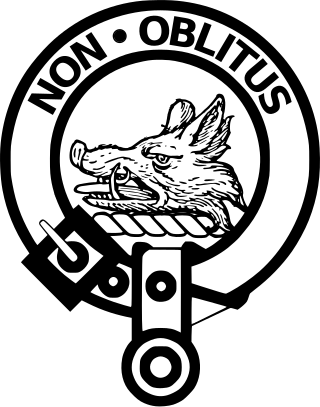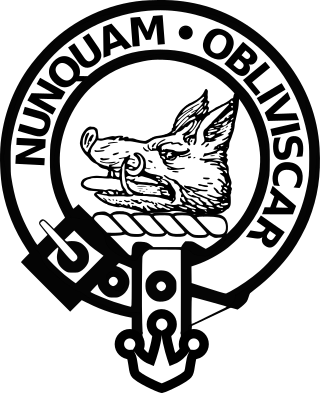Related Research Articles

Clan Campbell is a Highland Scottish clan, historically one of the largest and most powerful of the Highland clans. The Clan Campbell lands are in Argyll and within their lands lies Ben Cruachan. The chief of the clan became Earl of Argyll and later Duke of Argyll.

A Scottish clan is a kinship group among the Scottish people. Clans give a sense of shared heritage and descent to members, and in modern times have an official structure recognised by the Court of the Lord Lyon, which regulates Scottish heraldry and coats of arms. Most clans have their own tartan patterns, usually dating from the 19th century, which members may incorporate into kilts or other clothing.

Rothesay is the principal town on the Isle of Bute, in the council area of Argyll and Bute, Scotland. It lies along the coast of the Firth of Clyde. It can be reached by ferry from Wemyss Bay, which offers an onward rail link to Glasgow. At the centre of the town is the 13th-century ruin Rothesay Castle, unique in Scotland for its circular plan.
The Isle of Bute, known as Bute, is an island in the Firth of Clyde in Scotland, United Kingdom. It is divided into highland and lowland areas by the Highland Boundary Fault.

Clan Maclean is a Highlands Scottish clan. They are one of the oldest clans in the Highlands and owned large tracts of land in Argyll as well as the Inner Hebrides. Many early MacLeans became famous for their honour, strength and courage in battle. They were involved in clan skirmishes with the Mackinnons, Camerons, MacDonalds and Campbells, as well as all of the Jacobite risings.

Clan Murray is a Highland Scottish clan. The chief of the Clan Murray holds the title of Duke of Atholl. Their ancestors were the Morays of Bothwell who established the family in Scotland in the 12th century. In the 16th century, descendants of the Morays of Bothwell, the Murrays of Tullibardine, secured the chiefship of the clan and were created Earls of Tullibardine in 1606. The first Earl of Tullibardine married the heiress to the Stewart earldom of Atholl and Atholl therefore became a Murray earldom in 1626. The Murray Earl of Atholl was created Marquess of Atholl in 1676 and in 1703 it became a dukedom. The marquess of Tullibardine title has continued as a subsidiary title, being bestowed on elder sons of the chief until they succeed him as Duke of Atholl.
Bellenden is a surname, Scottish in origins and an older form of Ballantine/Ballantyne.

Clan Lamont is a Highland Scottish clan. The clan is said to descend from Ánrothán Ua Néill, an Irish prince of the O'Neill dynasty, and through him Niall Noigíallach, High King of Ireland. Clan Ewen of Otter, Clan MacNeil of Barra, Clan Lachlan, and Clan Sweeney are also descendants of Ánrothán. Traditional genealogy would therefore include Clan Lamont among the descendants of Conn Cétchathach.

Clan MacTavish is an Ancient Highland Scottish clan.

Clan MacAlister is a Scottish Clan. The clan is the earliest branch to have split off from Clan Donald, claiming descent from Alasdair Mòr, son of Domhnall founder of Clan Donald. From Alasdair Mòr the clans takes its surname MacAlister; this surname is an Anglicisation of the Gaelic MacAlasdair meaning "son of Alasdair". In the 15th century the chief of the clan was seated in Kintyre, and the clan was centred there until the 18th century, when a chief sold the family estate in preference to an estate in the Scottish Lowlands.

Clan Arthur or Clan MacArthur, is a highland Scottish clan that once held lands on the shores of Loch Awe opposite Inishail. The clan has been described as one of the oldest clans in Argyll. Clan Arthur and Clan Campbell share a common origin, and at one point the MacArthurs challenged the seniority of the leading Campbell family. A branch of MacArthurs from the Isle of Skye were a sept of the MacDonalds of Sleat, and were hereditary pipers for the MacDonalds of the Isles. In late 18th century the chief of the clan died without an heir, leaving the clan leaderless until the late 20th century. In 2002, the first chief of Clan Arthur was recognised in about 230 years.

Clan MacAulay, also spelt Macaulay or Macauley is a Scottish clan. The clan was historically centred on the lands of Ardincaple, which are today consumed by the little village of Rhu and burgh of Helensburgh in Argyll and Bute. The MacAulays of Ardincaple were located mainly in the traditional county of Dunbartonshire, which straddles the "Highland Line" between the Scottish Highlands and Lowlands. Clan MacAulay has been considered a "Highland clan" by writers and has been linked by various historians to the original Earls of Lennox and in later times to Clan Gregor. The MacAulays of Ardincaple, like Clan Gregor and several other clans, have traditionally been considered one of the seven clans which make up Siol Alpin. This group of clans were said to have claimed descent from Cináed mac Ailpín, King of the Picts, from whom later kings of Scotland traced their descent. The chiefs of Clan MacAulay were styled Laird of Ardincaple.
Bannatyne is a Scottish surname. It is also spelt Ballentine, Ballantyne, Ballantine, among others. It may refer to:

Clan MacIver or Clan MacIvor, also known as Clan Iver, is a Scottish clan recognised by the Lord Lyon King of Arms. The clan, however, does not have a chief recognised by the Lord Lyon King of Arms. Because of this the clan can be considered an armigerous clan. The clan name of MacIver is of Gaelic origin, derived from an Old Norse personal name. Various forms of the surname MacIver, like MacGiver, are considered sept names of several historically large Scottish clans, such as clans Campbell and Mackenzie. There exists a Clan Iver society in Fife, Scotland.

Clan MacEwen or Clan MacEwan is a Scottish clan recorded in the fifteenth century as Clan Ewen of Otter.

Sir Aulay MacAulay of Ardincaple was a Scottish laird, knight, clan chief, and a shire commissioner. He was the son and heir of Walter MacAulay Ardincaple, who was the laird of Ardincaple and chief of Clan MacAulay. The MacAulay estate of Ardincaple was situated in the location of the modern village of Rhu and Helensburgh, which both lie on the eastern shore of the Gare Loch, in Argyll and Bute. As chief of his clan, he entered into a contract with the chief of the MacGregors, pledging service and assistance to their chief. His clan feuded with the Buchanans, and his marriage to the widow of a deceased Galbraith chief brought forth feuding with that clan. He also feuded with the Campbells, particularly the Captain of Carrick. The Campbells made several attempts on his life and he was wounded one such encounter. Towards the end of his life he was knighted for his services. On his death he was succeeded by his first cousin.

Clan Campbell of Cawdor is a highland Scottish clan and a branch of the larger Clan Campbell. While the clan is recognised by the Standing Council of Scottish Chiefs, the clan does not have a clan chief recognised by the Standing Council of Scottish Chiefs. Also, because the clan does not have a clan chief recognised by the Lord Lyon King of Arms it is considered an armigerous clan. The head of the Clan Campbell of Cawdor is the Earl Cawdor, currently held by Colin Campbell.

Clan Stuart of Bute is a Highland Scottish Clan and is a branch of the larger Clan Stewart.
Scottish surnames are surnames currently found in Scotland, or surnames that have a historical connection with the country.

Clan MacPhail or the Sons of Paul is a Scottish clan of the Scottish Highlands. Known in Scottish Gaelic as Conchie Dhu or Condochy Doye, the clan is mainly associated with the confederation of Clan Chattan.
References
- ↑ "Ballantyne FYI". Archived from the original on 23 October 2008. Retrieved 2008-11-05.